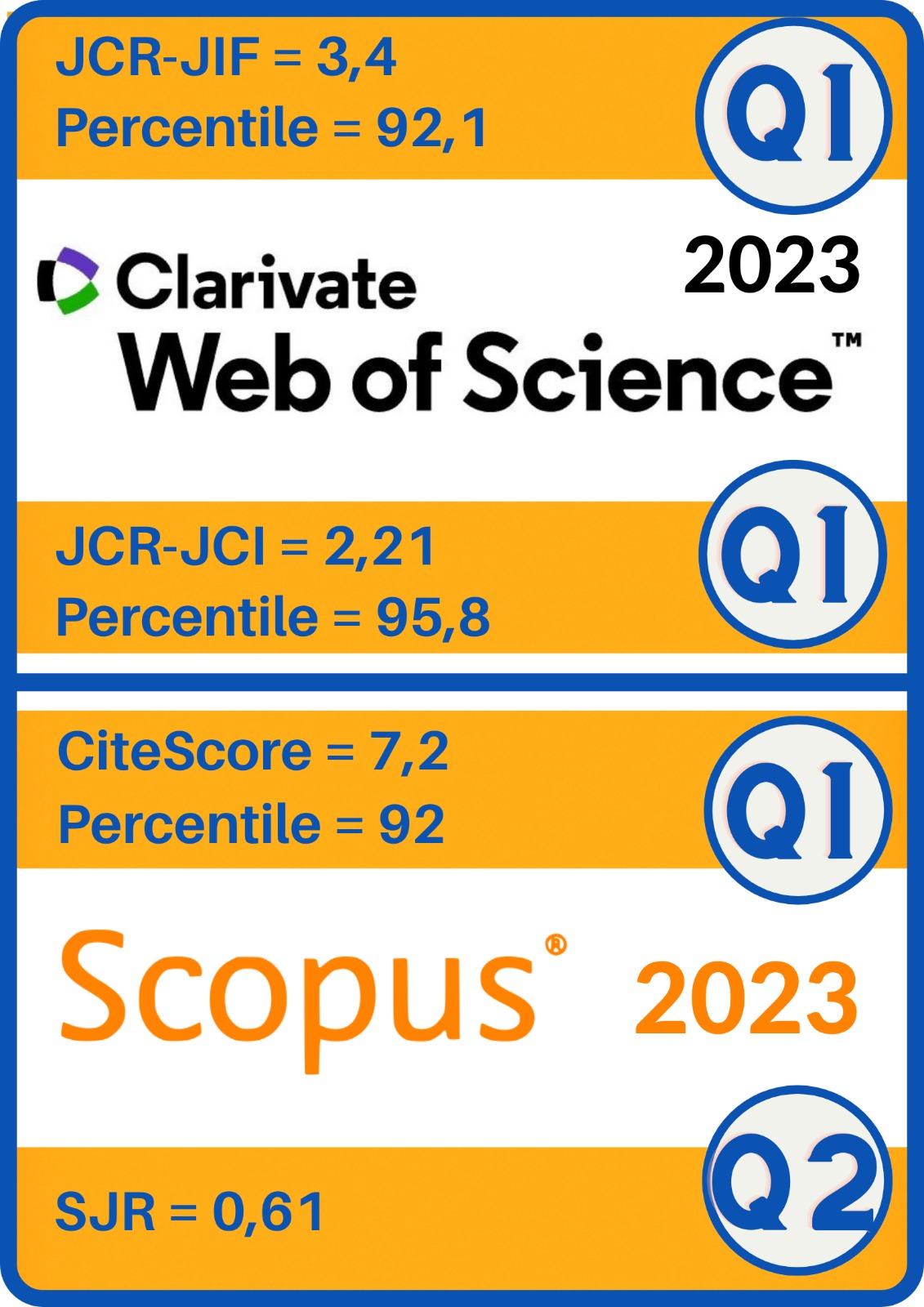HyFlex: Teaching and Learning in a Hybrid and Flexible Way in Higher Education
DOI:
https://doi.org/10.5944/ried.26.1.34023Keywords:
hybrid teaching, flexible learning, blended learning, educational technology, distance educationAbstract
This research paper analyses an experience in higher education based on the HyFlex (hybrid and flexible) model that was developed during three academic years (2019, 2020, 2021). Unlike other HyFlex approaches, where face-to-face teaching is broadcast online and students choose whether to attend the physical classroom or participate telematically, in this experience the hybrid consisted of a combination of face-to-face lessons with autonomous work by students in an asynchronous virtual classroom. Likewise, flexibility was based on the students' free choice of the learning modality or strategy to be followed (by projects versus units of study). A descriptive analysis methodology was used to carry out the study, based on the opinion survey method and the analysis of the academic performance grades obtained by the students. The results show a high degree of satisfaction and positive assessment from the students’ perspectives. It has also been identified that there is a high level of academic achievement irrespective of the chosen pathway. It is concluded that this implemented HyFlex model has the potential to be transferable and put into practice any university subject of face-to-face teaching which require being transformed digitally. For this, it is necessary that the appropriate institutional conditions exist and that the teaching staff have the appropriate pedagogical and digital competence.
FULL ARTICLE:
https://revistas.uned.es/index.php/ried/article/view/34023/26878
Downloads
References
Abdelmalak, M. M. M., y Parra, J. L. (2016). Expanding learning opportunities for graduate students with HyFlex course design. International Journal of Online Pedagogy and Course Design (IJOPCD), 6(4), 19-37. https://doi.org/10.4018/IJOPCD.2016100102
Area-Moreira, M. (2020). El diseño de cursos virtuales: conceptos, enfoques y procesos pedagógicos. En J.M. García y S. García (Comp.), Las tecnologías en (y para) la educación. FLACSO Uruguay Publicaciones. https://publicaciones.flacso.edu.uy/index.php/edutic/article/view/4/5
Area-Moreira, M. (2021). La enseñanza remota de emergencia durante la Covid-19. Los desafíos postpandemia en la Educación Superior. Emergency Remote Teaching during Covid-19 in Higher Education. The Post-pandemic Challenges. Propuesta Educativa, 30(56), 57-70. http://propuestaeducativa.flacso.org.ar/wp-content/uploads/2022/04/REVISTA-56-Dossier-AREA-MOREIRA.pdf
Area-Moreira, M., Bethencourt-Aguilar, A., Martín-Gómez, S., y San Nicolás-Santos, M. B. (2021). Análisis de las políticas de enseñanza universitaria en España en tiempos de Covid-19. La presencialidad adaptada. Revista de Educación a Distancia (RED), 21(65). https://doi.org/10.6018/red.450461
Area-Moreira, M., Bethencourt-Aguilar, A., y Martín-Gómez, S. (2020). De la enseñanza semipresencial a la enseñanza online en tiempos de Covid-19. Visiones del alumnado. Campus Virtuales, 9(2), 35-50. http://www.uajournals.com/campusvirtuales/journal/17/3.pdf
Barlow, A., Adekola, J., y Siddiqui, N. (2021). Current and future online and blended learning provisions. Journal of Perspectives in Applied Academic Practice, 9(2), 39-53. https://doi.org/10.14297/jpaap.v9i2.480
Beatty, B. (2010). Hybrid courses with flexible participation. HyFlex. Unpublished manuscript. http://itec.sfsu.edu/HyFlex/HyFlex_course_design_theory_2.2.pdf
Beatty, B. (2012). HyFlex course design: The advantages of letting students choose the blend. Proceedings of the 9th Annual Sloan Consortium Blended Learning Conference & Workshop. http://sloanconsortium.org/conference/2012/blended/HyFlex-course-design-advantages-letting-students-choose-blend
Beatty, B. (2014). Hybrid Courses with Flexible Participation: The HyFlex Course Design. En L. Kyei-Blankson, y E. Ntuli (Eds.). Practical Applications and Experiences in K-20 Blended Learning Environments, 153-177. IGI Global. https://doi.org/10.4018/978-1-4666-4912-5.ch011
Beatty, B. J. (2019). Hybrid-Flexible Course Design. EdTech Books. https://edtechbooks.org/HyFlex
Bostock, J. R. (2018). A Model of Flexible Learning: Exploring Interdependent Relationships Between Students, Lecturers, Resources and Contexts in Virtual Spaces. Journal of Perspectives in Applied Academic Practice, 6(1), 12-18. https://doi.org/10.14297/jpaap.v6i1.298
Brown, M. G. (2016). Blended instructional practice: A review of the empirical literature on instructors' adoption and use of online tools in face-to-face teaching. The Internet and Higher Education, 31, 1-10 https://doi.org/10.1016/j.iheduc.2016.05.001
Cronje, J. C. (2020). Towards a new definition of Blended Learning. Electronic Journal of E-Learning, 18(2), 114-121. https://doi.org/10.34190/EJEL.20.18.2.001
De Benito, B., Mesquida, A. D., y Salinas, J. M. (2012). Los itinerarios de aprendizaje mediante mapas conceptuales como recurso para la representación del conocimiento. Edutec, 39, 1-14. https://doi.org/10.21556/edutec.2012.39.372
De Benito Crosetti, B., Lizana Carrió, A., Moreno García, J., y Salinas Ibáñez, J. M. (2022). Codiseño de itinerarios flexibles de aprendizaje para la enseñanza semipresencial y a distancia. En S. Olmos-Migueláñez, M. J. Rodríguez-Conde, A. Bartolomé, J. Salinas, F. J. Frutos-Esteban, y F. J. García-Peñalvo (Eds.), La influencia de la tecnología en la investigación educativa pospandemia (pp. 73-86). Octaedro.
Detyna, M., Sanchez-Pizani, R., Giampietro, V., Dommett, E. J., y Dyer, K. (2022). Hybrid flexible (HyFlex) teaching and learning: climbing the mountain of implementation challenges for synchronous online and face-to-face seminars during a pandemic. Learning Environments Research. https://doi.org/10.1007/s10984-022-09408-y
Garrison, D. R., y Kanuka, H. (2004). Blended Learning: Uncovering Its Transformative Potential in Higher Education. The Internet and Higher Education, 7, 95-105. https://doi.org/10.1016/j.iheduc.2004.02.001
Liu, C-Y. A., y Rodríguez, R. C. (2019). Evaluation of the impact of the HyFlex learning model. International Journal of Innovation and Learning, 25(4), 393-411. https://doi.org/10.1504/IJIL.2019.099986
Margulieux, L. E., McCracken W. M., y Catrambone, R. (2016). A taxonomy to define courses that mix face-to-face and online learning. Educational Research Review, 19, 104-118 https://doi.org/10.1016/j.edurev.2016.07.001
Pelletier, K., McCormack, M., Reeves, J., Robert, J., y Arbino, N. (2022): 2022 EDUCAUSE Horizon Report, Teaching and Learning Edition. EDUCAUSE. https://library.educause.edu/resources/2022/4/2022-educause-horizon-report-teaching-and-learning-edition
Petersen, A. K., Nortvig, A-M., y Hattesen, S. (2018). A literature review of the factors influencing e-learning and blended learning in relation to learning outcome, student satisfaction and engagement. Electronic Journal of E-Learning, 16(1), 46-55. https://files.eric.ed.gov/fulltext/EJ1175336.pdf
Salinas, J. (2013). Enseñanza Flexible y Aprendizaje Abierto, Fundamentos clave de los PLEs. En L. Castañeda y J. Adell (Eds.), Entornos Personales de Aprendizaje: Claves para el ecosistema educativo en red. Marfil. 53-70.
Salinas-Ibáñez, J., y De-Benito, B. (2020). Construction of personalized learning pathways through mixed methods. [Construcción de itinerarios personalizados de aprendizaje mediante métodos mixtos]. Comunicar, 65, 31-42. https://doi.org/10.3916/C65-2020-03
Sangrá, A. (2020). Epílogo: Hacia modelos de presencialidad discontinua o intermitente. En A. Sangrá (Coord.), Decálogo para la mejora de la docencia online. Repositorio institucional UOC Universitat Oberta de Catalunya. http://hdl.handle.net/10609/122307
Sousa Santos, S., Peset González, M. J., Muñoz-Sepúlveda, J. A. (2021). La enseñanza híbrida mediante flipped classroom en la educación superior. Revista de Educación, 391. Enero-Marzo 2021, 123-147. https://doi.org/10.4438/1988-592X-RE-2021-391-473









